Global Sugarcane Bagasse Fibre Market Poised for Robust Growth, Projected to Reach USD 2.18 Billion by 2035
Global sugarcane bagasse fibre market to reach USD 2.18B by 2035, led by paper & packaging applications and strong growth in Brazil.
ROCKVILLE PIKE, MD, UNITED STATES, October 1, 2025 /EINPresswire.com/ -- The global sugarcane bagasse fibre market is experiencing significant growth, with projections indicating an expansion from USD 1,100.0 million in 2025 to approximately USD 2,184.2 million by 2035, reflecting a compound annual growth rate (CAGR) of 7.1%. Rising demand for sustainable packaging, increasing adoption in paper manufacturing, and the push for eco-friendly materials are driving this growth across global markets.Market Overview
Sugarcane bagasse fibre, a by-product of sugar production, is widely utilized as a renewable and biodegradable raw material. Its applications span paper and packaging, textiles, bio-composites, and construction materials, making it an attractive option for industries seeking sustainable alternatives to wood pulp and synthetic fibers.
Paper and packaging applications are projected to lead the market, capturing a 50% share in 2025, due to the increasing adoption of eco-friendly packaging solutions and stringent regulations against single-use plastics in North America, Europe, and Asia-Pacific.
Full Market Report available for delivery. For purchase or customization, please request here – https://www.factmr.com/connectus/sample?flag=S&rep_id=11101
Regional Market Analysis
Brazil
Brazil is anticipated to exhibit the highest growth rate, with a CAGR of 9.0%. The country benefits from abundant sugarcane production, established bagasse processing facilities, and government initiatives promoting sustainable industrial practices.
North America
The U.S. and Canada are driving demand for bagasse fibre in paper products, packaging, and molded fiber trays. Regulatory support for renewable materials and consumer preference for sustainable products are key growth drivers.
Europe
European countries, including Germany, France, and the U.K., are witnessing increased adoption of sugarcane bagasse in packaging due to environmental policies restricting plastics and promoting biodegradable alternatives.
Asia-Pacific
Countries such as India, China, and Thailand are emerging as high-growth markets, driven by rapid industrialization, increasing paper production, and rising awareness of sustainable materials.
Browse Full Report https://www.factmr.com/report/sugarcane-bagasse-fibre-market
Application Insights
Paper and Packaging
Paper and packaging remain the dominant application, accounting for half of the market in 2025. Bagasse fibre is increasingly used for paperboards, cartons, and molded packaging due to its strength, cost-effectiveness, and eco-friendly profile.
Bio-composites and Construction
Bagasse fibre is gaining traction in bio-composites, fiberboards, and building materials, driven by the demand for renewable and biodegradable alternatives to wood and synthetic fibers.
Textiles
Though a smaller segment, the use of bagasse fibre in textile manufacturing is expanding, particularly in the production of non-woven fabrics and eco-friendly fibers.
Market Drivers
Rising Environmental Awareness – Increasing consumer and corporate preference for sustainable, biodegradable materials fuels bagasse fibre adoption.
Government Regulations – Policies restricting plastics and promoting renewable materials support market expansion.
Growth of Paper and Packaging Industry – Rising e-commerce, food delivery, and consumer goods demand increase packaging needs, driving bagasse fibre consumption.
Abundant Raw Material Supply – Sugarcane-growing countries provide a stable and cost-effective source of bagasse for industrial applications.
Market Challenges
Processing and Quality Variability – Differences in bagasse fibre quality and processing standards can affect product consistency.
Competition from Alternative Fibres – Wood pulp and synthetic fibers remain widely used, posing a competitive challenge.
Infrastructure Limitations – Limited availability of advanced processing facilities in some regions may constrain growth.
Competitive Landscape
The global sugarcane bagasse fibre market is moderately consolidated, with key players focusing on capacity expansion, technological innovation, and strategic partnerships.
Key Players
PT Perkebunan Nusantara XI (Indonesia) – Leading producer of bagasse-based pulp and packaging materials.
Jindal Poly Films Limited (India) – Offers biodegradable bagasse packaging solutions for industrial applications.
Tata Chemicals Limited (India) – Provides bio-composite and paper-grade bagasse fibres.
Sugarcane Bagasse Co. (Brazil) – Supplies raw bagasse fibre to the paper and packaging sector.
WestRock Company (U.S.) – Integrates bagasse fibre in molded fiber trays and eco-friendly packaging products.
Leading companies focus on product innovation, capacity expansion, and global distribution networks to maintain a competitive edge and capitalize on rising demand.
Recent Developments
Expansion of molded fiber packaging lines in Brazil and India to meet growing e-commerce demand.
Introduction of high-strength bagasse paperboards suitable for premium packaging applications.
Strategic collaborations between sugar producers and paper manufacturers to streamline bagasse collection and processing.
Development of bio-composites and fiberboards using bagasse fibre for construction and furniture applications.
Future Outlook
The global sugarcane bagasse fibre market is expected to witness robust growth over the next decade:
Paper and packaging will remain the largest application segment, with continued adoption in biodegradable trays, cartons, and packaging materials.
Bio-composites and construction materials will see increased uptake as industries seek sustainable alternatives.
Emerging markets like Brazil, India, and China will drive overall growth, supported by abundant sugarcane production and increasing industrialization.
Technological advancements in bagasse processing will improve product quality and broaden applications.
Market Summary
The global sugarcane bagasse fibre market is projected to grow from USD 1,100.0 million in 2025 to approximately USD 2,184.2 million by 2035, with a CAGR of 7.1%.
Paper and packaging applications will dominate the market, while Brazil is expected to show the highest growth rate at 9.0% CAGR.
Key players focus on innovation, capacity expansion, and strategic partnerships to capitalize on rising demand for sustainable materials.
Check out More Related Studies Published by Fact.MR Research:
Sugarcane Fiber Market https://www.factmr.com/report/4927/sugarcane-fiber-market
Wheat Fibre Market https://www.factmr.com/report/2803/wheat-fibre-market
Citrus Peel Fibre and Pectin Market https://www.factmr.com/report/citrus-peel-fibre-and-pectin-market
Papaya Seed Oil Market https://www.factmr.com/report/papaya-seed-oil-market
S. N. Jha
Fact.MR
+1 628-251-1583
email us here
Legal Disclaimer:
EIN Presswire provides this news content "as is" without warranty of any kind. We do not accept any responsibility or liability for the accuracy, content, images, videos, licenses, completeness, legality, or reliability of the information contained in this article. If you have any complaints or copyright issues related to this article, kindly contact the author above.

